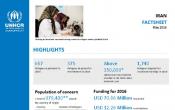Islamic Republic of Iran
Operation: Islamic Republic of Iran
Location
{"longitude":55,"latitude":33,"zoom_level":5}
Latest update of camps and office locations 13 Jan 2016. By clicking on the icons on the map, additional information is displayed.
Key Figures
| 2015 end-year results | |
| 83,000 | refugees were enrolled in the national health insurance scheme, out of which 58,000 were vulnerable refugees |
| 3 | schools were constructed/renovated |
| 889 | refugees departed for resettlement |
| 2016 planning figures | |
| 157 | health facilities equipped/constructed/rehabilitated |
| 24 | educational facilities constructed or improved |
| 3,500 | people of concern enrolled in formal national institutions for certified skills training |
| 6,000 | people of concern receiving legal assistance |
Latest Updates
People of Concern
0%
Decrease in
2015
2015
| 2015 | 979,491 |
| 2014 | 982,085 |
| 2013 | 857,402 |

[["Refugees",979437],["Asylum-seekers",42],["Returned refugees",12]]
Loading ...
Budgets and Expenditure for Islamic Republic of Iran
< Back
2015
{"categories":[2012,2013,2014,2015,2016],"budget":[53.22125512,59.5882886,68.48044209,72.823781737,76.76538033],"expenditure":[30.85165641,38.43715452,30.14519856,21.93132368,null]}
{"categories":[2012,2013,2014,2015,2016],"p1":[53.22125512,59.5882886,68.48044209,72.823781737,76.76538033],"p2":[null,null,null,null,null],"p3":[null,null,null,null,null],"p4":[null,null,null,null,null]}
{"categories":[2012,2013,2014,2015,2016],"p1":[30.85165641,38.43715452,30.14519856,21.93132368,null],"p2":[null,null,null,null,null],"p3":[null,null,null,null,null],"p4":[null,null,null,null,null]}
Loading ...
CHOOSE A YEAR
- 2014
- 2015
- 2016
Working environment
- The Islamic Republic of Iran was the world’s fourth largest refugee-hosting country in 2015, with one of the largest and most protracted Afghan refugee populations.
- In a welcome move, the Government of the Islamic Republic of Iran expanded the coverage of its universal health insurance scheme to include all refugees.
- Following the Supreme Leader’s decree in May 2015, some 50,000 undocumented Afghan children were enrolled in the national education system for the 2015-2016 academic school year, which resulted in a stronger and more favorable protection space for refugees and undocumented Afghans.
- The number of refugees who chose to voluntarily repatriate continued to decrease in 2015 as the security situation in Afghanistan and Iraq deteriorated.
- The Governments of the Islamic Republics of Afghanistan and Iran agreed to register undocumented Afghans in Iran, the number of which is estimated to be around 1 million.
Population trends
- According to the Government’s registration data, the Islamic Republic of Iran hosted approximately 979,400 refugees in 2015 – including over 951,100 Afghans and 28,250 Iraqis.
- Over 50 per cent of the refugee population are children and approximately 97 per cent live in urban areas while 3 per cent reside in 20 settlements.
- Approximately 2,850 Afghans and 100 Iraqis voluntarily repatriated to their respective countries of origin in 2015.
Achievements and impact
- UNHCR’s activities continued to focus on youth empowerment by offering education and skills training opportunities within the framework of the Solutions Strategy for Afghan Refugees (SSAR).
- UNHCR collaborated with the Government to construct additional schools and classrooms in order to increase access to education for refugees and undocumented children.
- UNHCR supported refugees’ access to livelihood activities in the Islamic Republic of Iran, specifically through certified skills training for young adults.
- UNHCR worked with the Government of the Islamic Republic of Iran to ensure access to its universal health insurance scheme for all refugees; UNHCR contributed to the Government’s efforts by covering the insurance premium for vulnerable refugees.
Unmet needs
- Due to funding shortfalls, UNHCR was only able to finance the construction for 3 out of 5 of the originally planned schools. This prevented an increase in the number of refugee children who were able to attend school in 2015.
- Primary healthcare services were also reduced due to resource constraints.
Working environment
Despite the voluntary return of hundreds of thousands of Afghan and Iraqi refugees to their countries of origin during the past decade, the Islamic Republic of Iran remains host to one of the world’s largest and most protracted refugee populations.Between January 2002 and June 2014, UNHCR assisted 918,263 Afghans in voluntarily returning home from the Islamic Republic of Iran. A total of 30,349 Iraqi refugees have been assisted to repatriate voluntarily since 2003. However, the number of people who have returned in 2013-2014 is lower than in previous years, so they require continued assistance.
The global economic downturn, removal of subsidies, and intensified international sanctions have caused hyperinflation, affected the delivery of basic services, and resulted in a dramatic rise in living costs in the Islamic Republic of Iran. Some 24 per cent of registered refugees are considered vulnerable, a rate that is expected to increase due to the economic situation.
Sanctions also continue to negatively impact UNHCR’s ability to provide humanitarian assistance in an effective and timely manner. High inflation rates have substantial consequences for both the operation and partners.
The Government of the Islamic Republic of Iran plays an active role in the Solutions Strategy for Afghan Refugees (SSAR). This strategy promotes a holistic approach to enhancing prospects of sustainable returns and attaining a permanent solution for the protracted refugee situation.
The Government is the primary contributor to the country’s refugee programmes through its ministries. Additional support is provided through semi-governmental organizations and social charities.
Needs and strategies
The organization will aim to bolster the country’s asylum space by supporting the Government, and will support building refugees’ human capital in preparation for a sustainable return to their country of origin or to a third country.The programme focuses on health, education, livelihood generation and durable solutions. Hence, projects will empower refugees to contribute to reconstructing Afghanistan and facilitate their reintegration upon eventual return. The implementation of cross-border initiatives will help prioritize projects and initiatives to increase their impact.
UNHCR will enhance its interventions in urban areas, where most vulnerable refugees reside. Future interventions in settlements will take into account the urgency of assistance, cost-effectiveness, and protection concerns. Interventions in settlements will be streamlined to ensure assistance does not become a pull-factor increasing the population, but rather improves the standard of living of existing residents and promotes peaceful coexistence with host communities.



